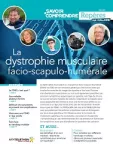Mots-clés
 > MYOBASE > BIOLOGIE > biologie par discipline > génétique > génétique moléculaire > MYOBASE > BIOLOGIE > biologie par discipline > génétique > génétique moléculaire
génétique moléculaireSynonyme(s)molecular genetics |
Documents disponibles dans cette catégorie (4909)
| Mettre toutes les notices dans le panier | Faire une suggestion | Ajouter un critère de recherche
Etendre la recherche sur niveau(x) vers le bas

Article
Bird TD | 21/03/2024Initial Posting: September 17, 1999; Last Revision: March 21, 2024. Clinical characteristics. Myotonic dystrophy type 1 (DM1) is a multisystem disorder that affects skeletal and smooth muscle as well as the eye, heart, endocrine system, an[...]
Article

Article
Raouf YS ; Sedighi A ; Geletu M ; Frere GA ; Allan RG ; Nawar N ; de Araujo ED ; Gunning PT | 28/12/2023
Article
Polveche H ; Valat J ; Fontrodona N ; Lapendry A ; Clerc V ; Janczarski S ; Mortreux F ; Auboeuf D ; Bourgeois CF | 21/12/2023
Article
Shoop WK ; Lape J ; Trum M ; Powell A ; Sevigny E ; Mischler A ; Bacman SR ; Fontanesi F ; Smith J ; Jantz D ; Gorsuch CL ; Moraes CT | 30/11/2023
Article
Rizzo F ; Bono S ; Ruepp MD ; Salani S ; Ottoboni L ; Abati E ; Melzi V ; Cordiglieri C ; Pagliarani S ; De Gioia R ; Anastasia A ; Taiana M ; Garbellini M ; Lodato S ; Kunderfranco P ; Cazzato D ; Cartelli D ; Lonati C ; Bresolin N ; Comi G ; Nizzardo M ; Corti S | 25/11/2023
Article
Kordala AJ ; Stoodley J ; Ahlskog N ; Hanifi M ; Garcia Guerra A ; Bhomra A ; Lim WF ; Murray LM ; Talbot K ; Hammond SM ; Wood MJ ; Rinaldi C | 19/09/2023
Article
Kakimoto T ; Ogasawara A ; Ishikawa K ; Kurita T ; Yoshida K ; Harada S ; Nonaka T ; Inoue Y ; Uchida K ; Tateoka T ; Ohta T ; Kumagai S ; Sasaki T ; Aihara H | 22/08/2023
Article

Article
Gibaut QMR ; Bush JA ; Tong Y ; Baisden JT ; Taghavi A ; Olafson H ; Yao X ; Childs-Disney JL ; Wang ET ; Disney MD | 26/07/2023
Article
Benslimane N ; Miressi F ; Loret C ; Richard L ; Nizou A ; Pyromali I ; Faye PA ; Favreau F ; Lejeune F ; Lia AS | 21/07/2023
Article

Article
Sikrova D ; Testa AM ; Willemsen I ; van den Heuvel A ; Tapscott SJ ; Daxinger L ; Balog J ; van der Maarel SM | 28/06/2023
Article
Laberthonniere C ; Delourme M ; Chevalier R ; Dion C ; Ganne B ; Hirst D ; Caron L ; Perrin P ; Adélaïde J ; Chaffanet M ; Xue S ; Nguyen K ; Reversade B ; Dejardin J ; Baudot A ; Robin JD ; Magdinier F | 19/06/2023
Article
La régénération musculaire dépend de la capacité des cellules souches musculaires, aussi appelées cellules satellites, à proliférer et à se différencier pour réparer les muscles endommagés. En l’absence de dommage, ces cellules sont quiescentes [...]
Publication AFM
Cukierman L, Auteur ; Sacconi S, Validateur ; Virginie De Bovis Milhe, Validateur ; Sanson B, Validateur ; Barrière A, Validateur ; Genet S ; Delille S, Validateur ; Goncalves C, Validateur | AFM-TELETHON | Savoir & Comprendre | 06/2023La dystrophie musculaire ou myopathie facio-scapulo-humérale (FSHD ou FSH) est une maladie génétique d’évolution lente qui touche les muscles du visage, des épaules et des bras. D’autres manifestations, musculaires ou non, sont également possibl[...]
Article
Yeetong P ; Kulsirichawaroj P ; Kumutpongpanich T ; Srichomthong C ; Od-Ek P ; Rakwongkhachon S ; Thamcharoenvipas T ; Sanmaneechai O ; Pongpanich M ; Shotelersuk V | 13/05/2023
Article

Article
Boujnouni NE ; Van der Bent ML ; Willemse M ; 't Hoen PAC ; Brock R ; Wansink DG | 20/04/2023
Article
Chatzovoulou K ; Mayeur A ; Cagnard N ; Zarhrate M ; Bole C ; Nitschke P ; Jabot-Hanin F ; Rotig A ; Monnot S ; Munnich A ; Frydman N ; Steffann J | England | 23/03/2023
Article
Ando M ; Higuchi Y ; Yuan JH ; Yoshimura A ; Dozono M ; Hobara T ; Kojima F ; Noguchi Y ; Takeuchi M ; Takei J ; Hiramatsu Y ; Nozuma S ; Nakamura T ; Sakiyama Y ; Hashiguchi A ; Matsuura E ; Okamoto Y ; Sone J ; Takashima H | England | 22/03/2023
Article

Article
Folland C ; Ganesh V ; Weisburd B ; McLean C ; Kornberg AJ ; O'Donnell-Luria A ; Rehm HL ; Stevanovski I ; Chintalaphani SR ; Kennedy P ; Deveson IW ; Ravenscroft G | United States | 14/03/2023





